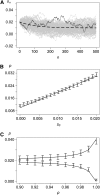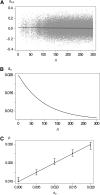Establishment of new mutations in changing environments
- PMID: 22542964
- PMCID: PMC3389982
- DOI: 10.1534/genetics.112.140756
Establishment of new mutations in changing environments
Abstract
Understanding adaptation in changing environments is an important topic in evolutionary genetics, especially in the light of climatic and environmental change. In this work, we study one of the most fundamental aspects of the genetics of adaptation in changing environments: the establishment of new beneficial mutations. We use the framework of time-dependent branching processes to derive simple approximations for the establishment probability of new mutations assuming that temporal changes in the offspring distribution are small. This approach allows us to generalize Haldane's classic result for the fixation probability in a constant environment to arbitrary patterns of temporal change in selection coefficients. Under weak selection, the only aspect of temporal variation that enters the probability of establishment is a weighted average of selection coefficients. These weights quantify how much earlier generations contribute to determining the establishment probability compared to later generations. We apply our results to several biologically interesting cases such as selection coefficients that change in consistent, periodic, and random ways and to changing population sizes. Comparison with exact results shows that the approximation is very accurate.
Figures





References
-
- Bartlett M., 1955. Stochastic Processes, with Special Reference to Methods and Applications. Cambridge University Press, Cambridge, UK/London/New York
-
- Bell G., 2008. Selection: The Mechanism of Evolution. Oxford University Press, London/New York/Oxford.
-
- Bell G., Gonzalez A., 2009. Evolutionary rescue can prevent extinction following environmental change. Ecol. Lett. 12: 942–948 - PubMed
-
- Beverton R., Holt S., 1957. On the Dynamics of Exploited Fish Populations (Fishery Investigations Series II), Vol. XIX Ministry of Agriculture, Fisheries and Food, London, UK
Publication types
MeSH terms
LinkOut - more resources
Full Text Sources

